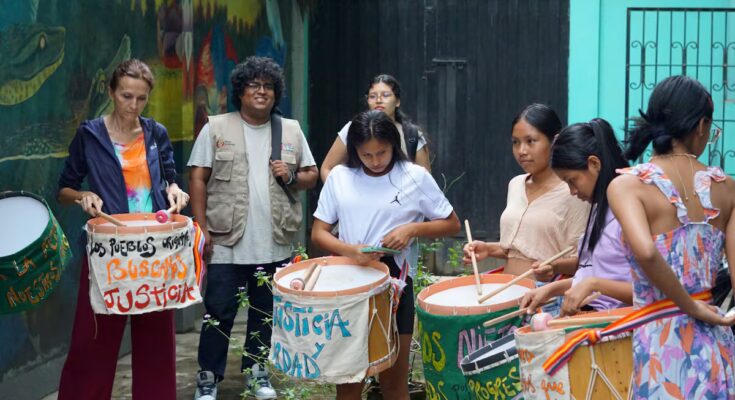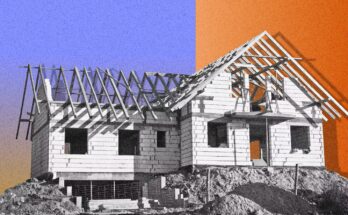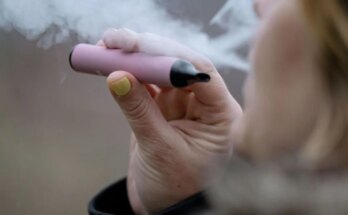EL PAÍS openly proposes the América Futura column for its daily and global informative contribution on sustainable development. If you want to support our journalism, subscribe Here.
Omar Navarro, 18 years old, tried to know his family tree and confirm whether he belonged to an indigenous people. In all that time, the answers he got increased the questions he asked himself. He consulted with his grandfather and, to learn about his origins, told him about the era of rubber: “My great-grandfather came to work for a master on the Marañón River, my grandfather told me that he went to work and returned almost nine months later, but with nothing, with debts… He came with lashes and whips,” says Navarro. He discovered that his great-grandfather belonged to the Kukama people, but had decided to abandon his language due to the constant discrimination he suffered, and also stopped teaching it to his children. “He told me this in a sad way, because he saw his father suffer just to feed his children,” he says.
In a quest to learn more about his roots, Navarro joined the TS+UNI collective, made up of 40 young people from 11 indigenous peoples of the Amazon. The group works to recover the history, culture and memory of their communities. Their most recent action was to ask the Peruvian state to create a truth commission to investigate one of the bloodiest chapters in the region: rubber fever. Young people describe that period as genocide and systematic exploitation, a story told without their voices. They ask that the State recognize the abuses and repair, even if belatedly, its historical memory. Research estimates that more than 30,000 indigenous people have died, although academics warn that there is no verifiable data to confirm that figure.
It was in a meeting between various peoples such as Kukama, Huitotos, Secoya, Achuar, Majuna, Bora, among others, that the young people heard the elders tell the stories of rubber. Dana Tello Morey, 25 years old and from the city of Kukama, says: “Our grandparents, our ancestors, were treated so cruelly and inhumanely that it seemed that at that time there was no one who could protect their rights. There are heartbreaking stories of children being burned in piles of fire or little girls being raped.” These intergenerational stories conveyed “pain and trauma”, he adds, but he also explains that “the need arose to do something about these wounds that have not healed”.
Young people remember the boom of rubber – which occurred between the end of the nineteenth century and the beginning of the twentieth century – with raids, when rubber collectors organized armed expeditions to kill, recruit or punish. They speak of the times when their tongues were cut out to speak their language, of the rapes of women and girls, of debts imposed by masters inherited for generations, of diseases brought from outside and of forced displacements that caused the disintegration of entire communities.
Juan Carlos La Serna, specialist in Amazon history and professor at the Universidad Nacional Mayor de San Marcos, explains that in that period an elitist vision of the Amazon as a territory of resources to be exploited prevailed. This also meant that physical violence at that time “was much more brutal, due to the very dynamic that required greater productivity at the expense of work,” he argues. And he adds that this process was accompanied by a “discourse on the savage” which legitimized the abuse..
María Ochoa, a 20-year-old girl from the town of Murui Bue, says she learned about this story thanks to her family. “I have never read a book that recounted all the atrocities committed by rubber tappers,” he says. His grandmother, for example, had one ear cut off. Ochoa says some question his request: “They tell me: they didn’t whip you, they didn’t cut out your tongue, they didn’t punish you. But it hurts me, because it was my tribe, they are part of me,” he says.
TS+UNI members live in various parts of the Peruvian jungle and others live in Brazil and Colombia. To work, the young people were divided into commissions, depending on what each one studies or practices. The case, brought in the Mixed Court of Nauta of the Superior Court of Justice of Loreto, was promoted with the support of two lawyers and the community radio Ucamara. They also had the support of popular grassroots organizations.
They emphasize that the group’s sole objective is not this legal action, but rather various national and international activities to protect and strengthen their territories, their culture and the relationship between indigenous peoples and the State. “We’re talking about indigenous peoples as something distant from Peru, as something separate. It’s important to rethink how we as a country perceive ourselves,” Tello says.
The request, while asking for a commission on events that occurred in past centuries, is linked to what still happens today in the Amazon. Patrick Murayari, 28 years old, also from the town of Kukama, explains: “First it was rubber, now it is oil, mining or wood. The dynamics of exploitation continue to repeat themselves in complicity with the State.” For this reason they also ask to address the current problems linked to extractive activities “which threaten communities and the territory”, he explains.
For Amnesty International, which accompanies the group, this action should serve to reflect on the current problems of the region: “The Amazon continues to face the loss of languages, the vulnerability of its people, the decline of collective rights and the impossibility of protecting its territory,” explains Rosario Grados, program director of the organization. Furthermore, he states that “impunity or access to the truth does not prescribe, and in this sense neither does pain”.
The group is aware that the passage of time is working against them. Maruja Gormas, 27, from the city of Majuna and who lives in Putumayo, explains: “They ask us who we will listen to, because more than a hundred years have passed. They tell us that it is better to leave it in the past.” But this is precisely the reason that drives them to act now. “Maybe years will pass and those voices will no longer be heard,” he says, referring to the last elderly people who still have direct memory of the rubber era.
Serna explains that, unlike other countries such as Colombia, which in recent years has demanded and positioned a historical and critical reflection on this episode from the State, Peru has not done so. This is why young people’s demand is important. However, he believes that the moment is complicated in Peru because we live in a period in which discourses of memory are harshly rebuked: “The conservative wave we are experiencing is also a denialist wave,” he indicates.
The reasons that led young people to join the TS+UNI collective are different: from reclaiming the history of their people, to bringing justice to their homes and healing wounds. Katty Ordoñez, 23, whose great-grandfather Kukama was tortured by rubber tappers, says: “I want my grandfather to be able to close a stage in his life. Maybe emotionally he won’t be able to do it because he will always be present, but at least he will have a bit of justice, that the State will begin to do what it always should have done: protect us and not kill us.”



